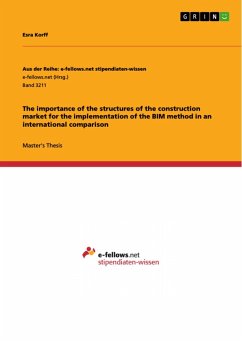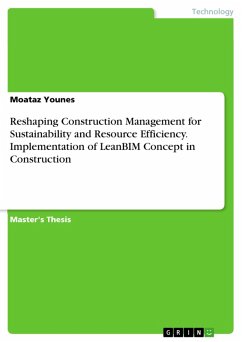Master's Thesis from the year 2019 in the subject Engineering - Civil Engineering, Technical University of Braunschweig (Institut für Bauwirtschaft und Baubetrieb), language: English, abstract: "Why is Germany behind the UK, US and Finland in BIM and how can Germany catch up again?" Over the years of the rise of BIM, numerous scientific papers have been written in various countries about structural barriers to BIM. Sometimes about structural barriers that exist in certain countries, like Becerik-Gerber / Rice's (2010) "The perceived value of building Information Modeling in the U.S. Building Industry", structural barriers that exist in certain areas, like Jeong et al.'s (2015) "BIM acceptance model in construction organisations", or general investigations in structural barriers to BIM, like Azahr et al.'s (2017) "Building Information Modelling (BIM) uptake: Clear benefits, understanding its implementation, risks and challenges". Scientific papers about structural barriers to BIM in Germany are, however, still rare and mostly in form of statistics, such as Braun et al. (2015). To conduct a comprehensive search for structural barriers to BIM and corresponding solutions in Germany, an individual approach is hence chosen. In a broad international literature review, potential structural barriers to BIM are identified from different sources, such as the ones named above. On the basis of such possible barriers to BIM, a comparison of Germany with the BIM leading countries, UK, US and Finland is conducted. This shall reveal what structural barriers are in effect in Germany that are non-existent or already overcome in the other countries, to derive corresponding suggestions for Germany. Where a differentiation between market participants is necessary in this work, the focus is put on contractors. To conduct this research, the course of this work is chosen as the following. It starts in the second chapter with a roundup about BIM and its potential, to provide a common information base for this work. In the third chapter, it is then documented how the UK, US and Finland are ahead of Germany with regard to BIM. As the reasons for these countries' advantage are to be found in a comparison with Germany, the methodology for such case study analysis is developed in the fourth chapter. Following this methodology, possible structural barriers to BIM of a countries AEC industry are identified in the fifth chapter. In the sixth chapter, the UK, US and Finland are compared with Germany according to these identified structural barriers, to find out where significant differences exist. [...]
Dieser Download kann aus rechtlichen Gründen nur mit Rechnungsadresse in A, B, BG, CY, CZ, D, DK, EW, E, FIN, F, GR, HR, H, IRL, I, LT, L, LR, M, NL, PL, P, R, S, SLO, SK ausgeliefert werden.









